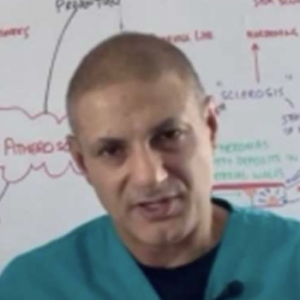Can our dreams predict the future? Can our dreams tell us if we’re suffering from an illness such as Parkinson’s disease? Can our bodies subconsciously tell us something is wrong? Can our dreams behave like our own Spider-Sense, warning us of impending doom?
It sounds like something straight out of a Marvel movie, but researchers have come to the stunning realisation that our dreams aren’t disconnected from our bodies. The connection between the dreaming mind and health is far more intricate than previously thought.
Dream enactment and Parkinson’s disease
In the mysterious realm of sleep, the phenomenon of REM Sleep Behaviour Disorder (RBD) has been gaining. It’s like a window into the deeper workings of our brains, offering clues about potential future health challenges.
When you dream, you become the star of your nocturnal action-packed adventure. The barrier between the parallel world of dreaming and reality is impenetrable for most of us. But for an unfortunate minority, cracks start to appear, and dreams don’t just play out in their minds—they act them out, too. Men over fifty are particularly prone to this, engaging in punches, kicks, and wrestling matches with invisible adversaries. Sometimes, these dream dramas become real-life nightmares, with partners unknowingly caught in the crossfire.
Researchers are beginning to recognise that a specific combination of symptoms involving men in their fifties acting out their dreams is associated with a 97% chance of developing Parkinson’s disease or Lewy body dementia within fourteen years. This is assuming that all other causes for the dream enactment have been ruled out, and there’s no known cause for the RBD.
REM Sleep Behaviour Disorder isn’t just about dreams—it’s about what those dreams reveal about our future health. It turns out that RBD can be a crystal ball for synucleinopathies like Parkinson’s disease and Lewy body dementia. It’s like having an early warning system built into our nightly adventures.
REM and dreams
Dreams occur during REM sleep, and to prevent us from acting out our dreams, our bodies become paralysed, except for the muscles which help us breathe and our eye muscles – well, they don’t call it Rapid Eye Movement sleep for nothing!
There’s a good reason for this; imagine if you started acting out your dreams. You might think you could fly, like Superman (I didn’t want to leave out DC fans, hence the Superman reference) and test this theory from your bedroom window. It’s not so much of a problem if you live in a bungalow but more of an issue if you’re in a penthouse suite on top of a skyscraper.
What if you were fighting off hordes of assailants in your dream? Then, unfortunately, in your attempt to defend yourself in your sleep, you inadvertently lash out and physically strike your sleeping partner.
So, there’s a very good reason for our nocturnal paralysis during REM.
What is REM Sleep Behaviour Disorder or RBD?
RBD is defined by complex and aggressive behaviours, occasionally accompanied by dream-like thoughts and visuals, typically manifesting during the initial REM sleep phase. The development of this condition is associated with the lack of typical REM-induced muscle relaxation (atonia). In the absence of the normal paralysed state during dreaming, patients experience recurring episodes of acting out their dreams, ranging from minor hand gestures to violent actions like punching, kicking, or abruptly leaping out of bed.1
RBD during childhood and adolescence is uncommon and typically linked to conditions like narcolepsy or idiopathic hypersomnia, neurodevelopmental-neurodegenerative disorders, or structural abnormalities in the brainstem. It may also arise as a side effect of certain medications, such as selective serotonin reuptake inhibitors.2
REM Behaviour Disorder is essentially a disruption of the normal paralysis during REM sleep. It’s estimated to affect less than 1% of the population and typically shows up in those aged 50 or older. The phenomenon of acting out dreams during REM sleep was initially observed in animals. In the 1950s, while studying sleep in cats, researcher Michel Jouvet at the University of Lyon found that damage to a specific part of the cat’s brainstem, responsible for transmitting brain signals to the body, resulted in behaviours such as hissing, walking, fighting, or hunting during REM sleep. Despite exhibiting brain activity indicative of REM sleep, the expected muscle paralysis was absent.3
The next logical step for researchers was that if this occurred in animals, could it also happen in humans? It wasn’t until 1986 that REM sleep behaviour disorder (RBD) was identified in patients by Schenck and Mahowald.4
What’s the difference between RBD and sleepwalking?
RBD may seem similar to sleepwalking, technically known as parasomnia, but on closer observation, they can be seen to be two completely different phenomena. During RBD episodes, the eyes remain closed, and movements appear aimless, consisting of flailing or striking out. Interaction with the external environment is minimal, and individuals typically stay in bed. Speech during RBD episodes is often incomprehensible and characterised by shouting or swearing.
In contrast, sleepwalking involves individuals leaving their beds with open eyes as they engage in activities such as picking up objects or even performing complex tasks like driving. Speech during sleepwalking episodes is typically more coherent, with fully formed sentences. Occasionally, individuals may engage in limited, albeit nonsensical, conversations.
The nature of dreams also differs between RBD and sleepwalking. In RBD, dreams typically unfold as coherent narratives over time. In contrast, sleepwalking or night terrors often consist of disjointed visual imagery, such as collapsing walls, natural disasters, insects, or spiders. Another significant distinction lies in the timing of these events: sleepwalking occurs during deep NREM (non-rapid eye movement) sleep, whereas RBD, as implied by its name, occurs during REM (rapid eye movement) sleep.
What causes REM Behaviour Disorder?
Previously referred to as idiopathic, which means we have no idea what causes it, RBD is now revealing itself as a potential precursor to a group of brain diseases termed synucleinopathies. Recent research suggests that many individuals diagnosed with idiopathic RBD may be experiencing early signs of neurodegenerative conditions such as Parkinson’s disease and Lewy body disease.5
In studies examining the brains of individuals with RBD, researchers uncovered deposits containing a protein known as alpha-synuclein. The abnormal accumulation of alpha-synuclein is linked to the development of synucleinopathies. Alpha-synuclein, a small protein naturally found within neurons, regulates synaptic function. However, alpha-synuclein becomes misfolded in synucleinopathies, leading to the formation of aggregates or molecular gunk with detrimental effects. Moreover, these misfolded proteins can propagate from one cell to another, worsening cellular damage.
When alpha-synuclein accumulates in the basal ganglia, a critical region deep within the brain controlling movement, it triggers the hallmark symptoms of Parkinson’s disease, including tremors, bradykinesia (slow movement), and gait disturbances. However, investigations into Parkinson’s disease brains have revealed alpha-synuclein deposits in various parts of the nervous system, such as the olfactory bulb responsible for smell perception and the nerves innervating the gastrointestinal tract and blood vessels. Notably, these deposits also affect the brainstem, which regulates the initiation of REM sleep paralysis. Remarkably, these changes manifest years or even decades before the onset of observable Parkinson’s disease or other brain degenerative disorders. Therefore, it’s logical that some individuals may experience RBD during the early phases of these neurological conditions.
What are the dreams in RBD like?
Individuals experiencing RBD often describe their dreams as intense, aggressive, and filled with action. Reports from men aged 50 and older detail scenarios involving punching, kicking, wrestling, or fleeing from attackers or wild animals. Some individuals with RBD enact their dreams while remaining in bed. In contrast, others may inadvertently involve their partners in their dream scenarios, leading to unintended violent interactions upon awakening. Conversely, women with RBD typically have less aggressive dreams that don’t include confrontations with assailants.
One could argue that perhaps the violent dreams reflect the aggressive disposition of the men with RBD. However, researchers have found that the opposite is true. Men who scored lower on the daytime aggression questionnaire were found to be placid but turned into Mr Hyde whilst asleep. Which begs the question, was Dr Jekyll suffering from RBD?
Use your dreams as an early diagnosis for Parkinson’s disease
Imagine having a diagnostic tool that can foresee health issues years, even decades, in advance. That’s the power of RBD. We might uncover early signs of trouble brewing in our brains by paying attention to our dreams and how they spill over into reality.
As we navigate the realm of sleep and dreams, let’s remember the untapped potential that lies within. RBD isn’t just a quirky sleep disorder— it’s a glimpse into our brain’s inner workings and a potential predictor of future health challenges. It can help guide us to a future where early intervention is the norm for such devasting neurodegenerative conditions like Parkinson’s disease.
From adrenaline-fueled dream dramas to peaceful nocturnal journeys, how we dream could be the key to unlocking early intervention for conditions like Parkinson’s. So, next time you find yourself in the midst of a wild dream, pay attention—it could be your brain’s way of sending an important message.
References:
- Arnulf, I., 2012. REM sleep behaviour disorder: motor manifestations and pathophysiology. Movement Disorders, 27(6), pp.677-689.
- Kotagal, S., 2015. Rapid Eye Movement Sleep Behavior Disorder During Childhood. Sleep medicine clinics, 10(2), pp.163-167.
- Luppi, P.H., 2018. Jouvet’s animal model of RBD, clinical RBD, and their relationships to REM sleep mechanisms. Sleep Medicine, 49, pp.28-30.
- C.H. Schenck, S.R. Bundlie, M.G. Ettinger, et al. Chronic behavioural disorders of human REM sleep: a new category of parasomnia. Sleep, 9 (1986), pp. 293-308
- Sixel-Döring, F., Trautmann, E., Mollenhauer, B. and Trenkwalder, C., 2014. Rapid eye movement sleep behavioural events: a new marker for neurodegeneration in early Parkinson’s disease? Sleep, 37(3), pp.431-438.


